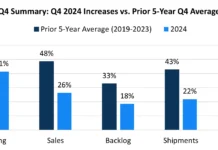by Jay Smith, senior manager, and Scott Walton, COO
Harbour Results, Inc.
As plastics processors look to develop a strategic plan for 2018 and beyond, it’s important to be aware of industry changes that may impact operations. Check out these five industry trends that are affecting or will affect plastics processors in the near future.
1. Automation
If plastics processors are not integrating automation into their entire manufacturing process, they already may be behind. It is becoming the norm for successful shops to leverage technology to improve efficiency and maximize capacity. Automation is just one tool in the tool kit, so processors should automate where appropriate and consider integrating systems – such as quality control, packaging and vision systems – into the shop’s overall infrastructure.
In the not so distant future, the industry can expect to see virtual work instructions, drone services, AR assembly and buyoff, and more throughout every plastics processing facility. It is critical that every tool supplier leverages today’s technology and takes meaningful steps toward automation use across the entire value stream.
Additionally, it is critically important for manufacturers to ensure they have the correct infrastructure in place to support the integration of automation. Leadership needs to have a short- and long-term integration plan that includes having the capital available for investment, the technical expertise to launch and maintain automation and a strategy to leverage automation to help differentiate products and processes.
2. 3D printing and additive manufacturing
Additive manufacturing and 3D printing are predicted to be highly disruptive forces within the manufacturing industry. Between 2016 and 2030, the global additive manufacturing market is set to shift from prototyping to mass production of parts and accessories.
Consumers are demanding new technology faster than ever before, and industries are working to meet the increased evolution of products. This cycle of technology is driving the need to increase the speed of product development across the plastics industry, from consumer goods to automotive to medical devices. And, these new processes are speeding up the pace of manufacturing.
Technology now is in place to make 4D prototyping a possibility: A prototype mold can be built in four to five days, where in the past it would take three to four weeks. Additionally, new valuation, modeling and scanning technologies have condensed development time, all driving the industry to become faster and more efficient.
3. Materials science
Materials are being developed to meet the necessary requirements for plastic products – strength, flexibility, etc. – but at a lower price than traditional raw materials. Researchers have discovered a new class of synthetic polymers that are strong, cheap, flexible, recyclable and self-healing. These are the world’s first family of materials that are strong and solvent-resistant, while being completely recyclable back to their original material. In the future, these materials could have a significant impact on nearly every engineering and product design category, as they can be used in a variety of manufacturing industries, including aerospace, airline and automotive.
Material strategies, including the use of automotive composites, will be critical for taking weight out of vehicles. The promise of lightweighting vehicles will be fully realized only if automakers adopt innovative manufacturing and engineering tools and processes that enable them to take full advantage of mixed materials, including composites.
Finally, carbon fiber, typically reserved for high-end products, is gaining increased acceptance because the material is nearly 50 percent cheaper than before. Manufacturers are expected to take advantage of this strong, lightweight material more frequently.
4. Environmental sustainability
Today’s manufacturers need to have a strategy throughout the company’s ecosystem for environmental sustainability. The best plastics processors are looking at every aspect of the business to determine how things can be done in a more efficient and sustainable way.
The global recycled plastics market reached a value of $37 billion in 2017. Increasing prices of conventional plastics, along with the growing concern for the environment, represent key factors driving the market. Recycling plastics reduces the amount of energy and natural resources needed to create virgin plastic. Therefore, shifting focus toward sustainability is boosting the demand for recycled plastics across the globe. In fact, the recycled plastics market is expected to reach a value of $51 billion by 2022.
Specifically, greater sustainability is a primary focus of the automotive industry. Plastics processors are committed to developing materials that are renewably sourced. For instance, Sorona® EP thermoplastic polymer contains 20 to 37 percent renewably sourced material (by weight) derived from non-food, plant-based material. Another high-performance solution is Hytrel® RS renewably sourced thermoplastic polyester elastomer, which contains 35 to 65 percent renewably sourced material derived from non-food, plant feedstocks. Many processors are developing polymers that use less petroleum than conventional polymers, which helps reduce carbon dioxide even further.
5. Changing role of product design
The gradually changing role of engineering service providers from being third-party vendors to gradually becoming key stakeholders in product development is driving the industry’s growth substantially. Previously, outsourced design services were limited to a lower degree of complexity, such as CAD drawing and designing. However, growing client confidence in plastics processors has led to the increasing complexity of outsourced activities, including the delivery of end-to-end solutions for a product.
Plastics processors that have the technology and capability to support product design have a competitive advantage and oftentimes provide a more cost-competitive solution.
Outside of these five trends, one of the top challenges plastics processors face – and will continue to face – is the skilled trades gap. This is a real issue affecting the entire manufacturing industry, not just plastic processors. Shop leadership must proactively address this issue and develop a strategy to secure talent. Linking the labor shortage to automating the right processes and ensuring that the entire value stream is connected are critical moves. Shops that approach talent retention with innovation at the forefront will be more effective in presenting manufacturing as an attractive career for the next generation – an efficient strategy in this competitive environment.
Last year was a strong year for plastics processors and, in the near-term, the industry will likely continue to be extremely busy – heavily influenced by the automotive industry. However, the North American economy is predicted to experience a slight dip, so it’s critical that plastics processors focus on making smart investments in technology, implementing a strategic plan and developing a workforce to remain competitive during the dip.
As a senior manager at Harbour Results, Inc., Jay Smith leads the assessment of cultural and operational issues impacting client performance and strategic execution. Scott Walton is chief operating officer at Harbour Results, Inc. With more than 30 years of experience in strategic planning, operations management, lean manufacturing and supply chain management, he has assisted multinational companies, government entities and business professionals worldwide. Harbour Results, Inc., is a business and operational consulting firm for the manufacturing industry, offering operational and strategic advisory expertise, as well as proprietary assessment programs, to help optimize a business’s performance.
More information: www.harbourresults.com.





